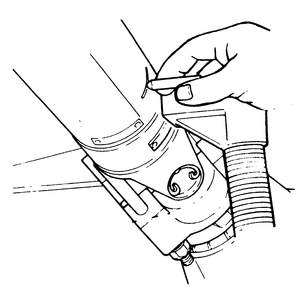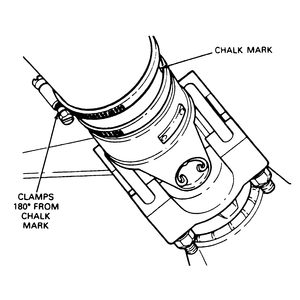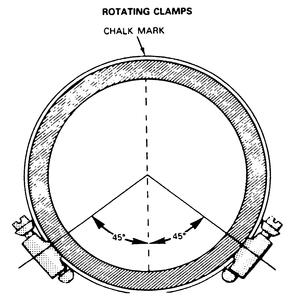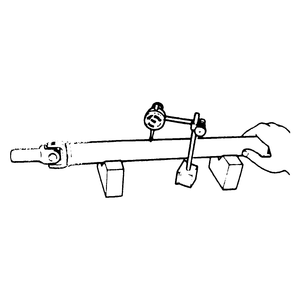| Fig. 1: Mark and number the shaft (yoke end) at four
positions 90apart.

|
| Fig. 2: If the vibration decreases, install a second
clamp

|
| Fig. 3: If the second clamp causes additional vibration,
rotate the clamps in opposite directions

|
Propeller shaft vibration increases as the vehicle speed is increased. A vibration
that occurs within a specific speed range is not usually caused by a propeller
shaft being unbalanced. Defective universal joints, or an incorrect propeller
shaft angle, are usually the cause of such a vibration.
If propeller shaft is suspected of being unbalanced, it can be verified with
the following procedure.
NOTE: Removing and re-indexing the propeller shaft 180relative
to the yoke may eliminate some vibrations.
- Raise and safely support the vehicle securely on jackstands.
- Clean all the foreign material from the propeller shaft and the universal
joints.
- Inspect the propeller shaft for missing balance weights, broken welds, and
bent areas. If the propeller shaft is dented or bent, it must be replaced.
- Inspect the universal joints to ensure that they are not worn, are properly
installed, and are correctly aligned with the shaft.
- Check the universal joint clamp bolt torque.
- Remove the wheels and tires. Install the wheel lug nuts to retain the brake
drums or rotors.
- Mark and number the shaft six inches (15.24cm) from the yoke end at four
positions 90apart.
- Run and accelerate the vehicle until vibration occurs. Note the intensity
and speed the vibration occurred. Stop the engine.
- Install a screw clamp at any position.
- Start the engine and re-check for vibration. If there is little or no change
in vibration, move the clamp to one of the other three positions. Repeat the
vibration test.
- If there is no difference in vibration at the other positions, the source
of the vibration may not be propeller shaft.
- If the vibration decreased, install a second clamp and repeat the test.
- If the additional clamp causes additional vibration, rotate the clamps ( 1⁄4 inch
above and below the mark). Repeat the vibration test.
- Increase distance between the clamp screws and repeat the test until the
amount of vibration is at the lowest level. Bend the slack end of the clamps
so the screws will not loosen.
- If the vibration remains unacceptable, apply the same steps to the front
end of the propeller shaft.
- Install the wheel and tires.
- Lower the vehicle.
| Fig. 4: Measure the front and rear shaft runout, replace
if the runout is excessive

|
- Remove dirt, rust, paint, and undercoating from the propeller shaft surface
where the dial indicator will contact the shaft.
- The dial indicator must be installed perpendicular to the shaft surface.
NOTE: Measure front/rear run-out approximately 3 inches
(76mm) from the weld seem at each end of the shaft tube for tube lengths
over 30 inches (76.2cm).
- Measure run-out at the center and ends of the shaft sufficiently far away
from weld areas to ensure that the effects of the weld process will not enter
into the measurements.
- Replace the propeller shaft if the run-out exceeds 0.035 inch (0.89mm) on
Navajo and 0.016 inch (0.40mm) on Pickup and MPV models.

